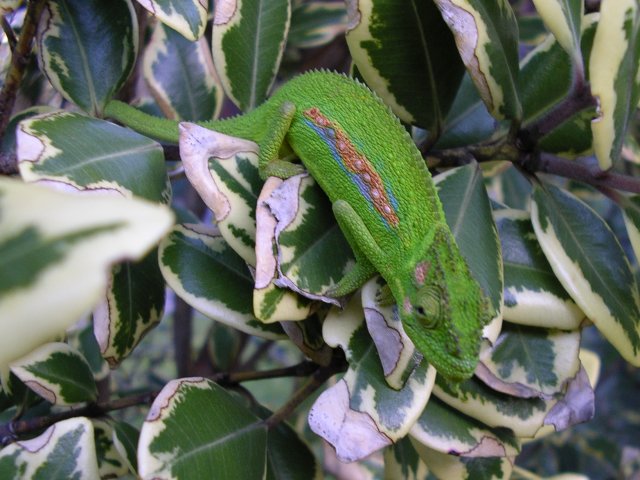- Cape Dwarf Chameleon
Taxobox
name = Cape Dwarf Chameleon

image_width = 250px
image_caption = Adult female
status =CITES lists as endangered
status_system =Endangered Species
regnum =Animal ia
phylum =Chordata
classis =Reptilia
ordo =Squamata
subordo =Iguania
familia =Chamaeleonidae
subfamilia =Chamaeleoninae
genus = "Bradypodion "
species = "B. pumilum"
binomial = "Bradypodion pumilum"
binomial_authority = (Gmelin,1789 )The Cape Dwarf Chameleon ("Bradypodion pumilum"), is achameleon native to the South African province of theWestern Cape where it is restricted to the region aroundCape Town . As with most chameleons, its tongue is twice the length of its body and it can be shot out of its mouth using a special muscle in the jaw. This gives the chameleon the ability to catch insects some distance away.Taxonomy
In the past most
South African dwarf chameleon s were considered to be asubspecies of the Capespecies [ [(e.g. Klaver & Böhme 1997).] ] This is now known to be wrong however; "B. pumilum" does not appear to have any particularly close living relatives. Like theKnysa Dwarf Chameleon it seems to be a basal offshoot of the ancestral stock which gave rise to all "Bradypodion". [ [(Tolley "et al." 2004).] ]Endangered status
The Cape Dwarf Chameleon is an
CITES -protectedendangered species . [ [tva-cee.satfrance.com/cites_base/documents/liste_especes_en.pdf Pdf. list of CITES-protected Endangered Species.] ]Description
The Cape Dwarf Chameleon is known to grow over 15cm in length, including the tail, with males and females reaching similar adult sizes. They are
ovoviviparous , but examination in controlled captivity has shown that there is a very soft egg-likemembrane around the young which is discarded immediately on birth. The young resemble miniature versions of the adults with muted colours, and typically reach no more than 2cm in length at birth. Adults can vary quite significantly in colour variety, saturation and pattern, some appearing much more vibrant than others. The tail is prehensile, and the feet are well evolved to grasping twigs, with minute claws on the end which improve their grip.Normally very slow moving, chameleons have a characteristic shake which may let them look more like leaves to prey and predators. When provoked, they can speed up to several centimetres a second. When further provoked, they will inflate themselves, hiss, change colour dramatically and bite. They do not have sharp teeth, so their bite rarely inflicts more than a slight pinch.
Chameleons in captivity
While it is not normally legal to keep these chameleons, it is possible to obtain special permission from the South African government to do so. These chameleons are better admired than handled, although taming is possible provided a very gentle and consistent (almost daily) contact and trust is built up. This is typically achieved through careful and slow hand-based feeding of flies, small spiders, grasshoppers, etc. They cannot survive outside of their natural environment and should remain outdoors where they are able to regulate body temperature using sunlight.
ee also
*
The South African Wine Initiative External links
*
References
* (1997): Liste der rezenten Amphibien und Reptilien - Chamaeleonidae. "Das Tierreich" 112: i-xiv, 1-85.
* (2004): Phylogenetics of the southern African dwarf chameleons, "Bradypodion" (Squamata: Chamaeleonidae). "Molecular Phylogenetics and Evolution" 30: 354–365. doi|10.1016/S1055-7903(03)00211-2 [http://academic.sun.ac.za/botzoo/tolley/tolley%20et%20al%20MPE%202004.pdf PDF fulltext]Gallery
Citations
Wikimedia Foundation. 2010.
